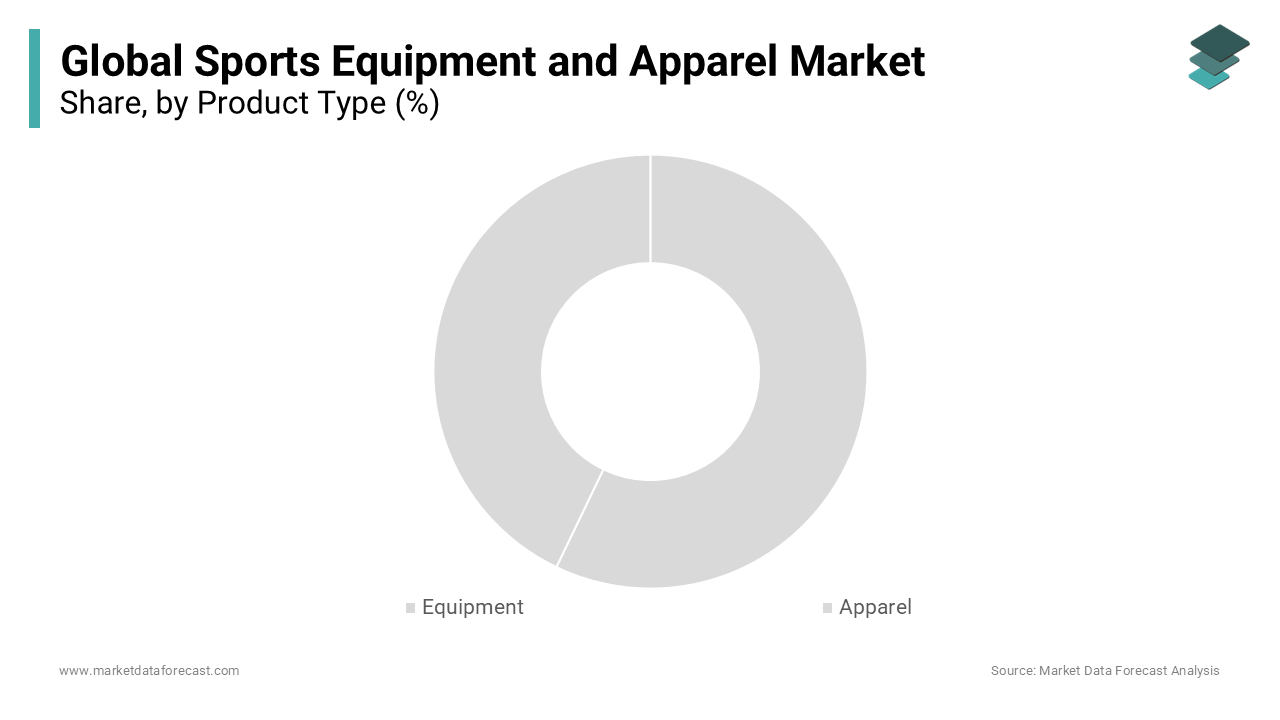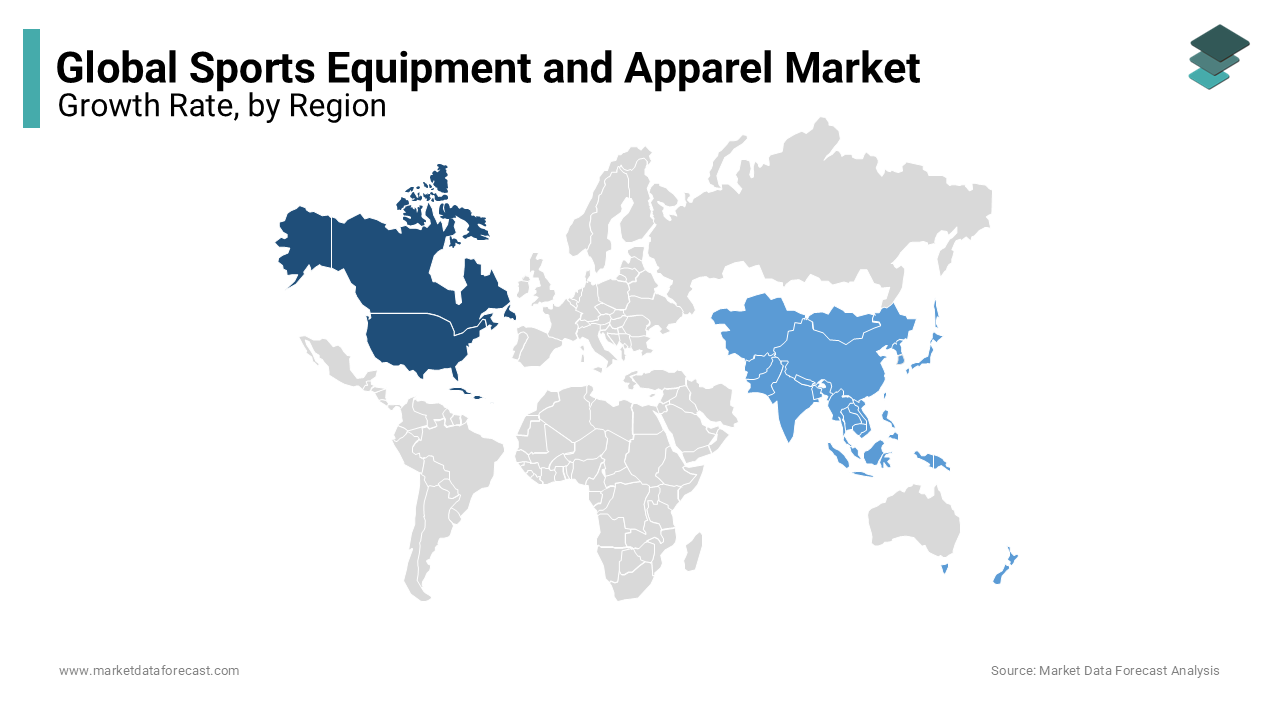Global Sports Equipment and Apparel Market Size, Share, Trends and Growth Forecast Report - Segmented By Product Type (Equipment and Apparel), Sports Type (Bike, Outdoor, Tennis, Other Racket Sports, Running, Fitness, Football/Soccer, Other Team Sports), Distribution Channel (Online and Offline), and Region (North America, Europe, Asia-Pacific, Latin America, Middle East and Africa) - Industry Analysis (2024 to 2032)
Global Sports Equipment and Apparel Market Size (2024 to 2032)
The Global sports equipment and apparel market size was valued at USD 514.50 billion in 2023. The global market size is expected to grow at a CAGR of 7.2% from 2024 to 2032 and be worth USD 961.91 billion by 2032 from USD 551.54 billion in 2024.

Current Scenario of the Global Sports Equipment and Apparel Market
Consumers are gradually spending on sports clothing and equipment alongside leisure clothing and accessories.
The sports industry is one of the largest developing industries in the world. Initially, the sport was part of military training to develop physical and mental capacities. Nowadays, more and more people are involved in sports and recreational activities due to health awareness and sports management. Sports as an activity helps consumers reap benefits such as improved physical and mental health, teamwork, responsibility, and a positive self-image. Following developments in the sports industry, various associations and federations have made the use of sports equipment compulsory according to the needs of the sport. The equipment provides protection against injury during sports.
MARKET DRIVERS
The growing fan base of popular sporting events such as the Olympics, Indian Premier League, FIFA, and others are fuelling the demand for sports equipment and apparel, driving the business growth.
Growing awareness of general health and fitness is one of the major drivers of market growth. In addition, constant improvements in the materials used to manufacture sports equipment help to improve the performance of the products, thus increasing the rate of adoption. The sports equipment industry has witnessed several changes recently because of the rising adoption of emerging technologies and the latest trends among the youth. Introducing innovative products is the way for manufacturers to stay in the competitive market, attract new consumers, and meet the needs of existing consumers.
The growth of the global sports equipment and apparel market can be attributed to the increased awareness of sports and fitness around the world.
In addition, rising spending on sports training and development in children due to augmented awareness of the benefits of participating in sports, such as increased focus and problem-solving ability, stimulates demand for sports equipment and clothing. In addition, the paradigm shift in the education system supports the growth of the sports industry and related industries. Also, the increase in sports education and sports training in academics has dramatically increased awareness of sports and fitness. Therefore, many schools/educational institutes provide training for students, giving them the opportunity to participate in various sports competitions. In addition, the surge in competitions at city, national and international levels carried out by various governments around the world leads to greater participation and interest of young people in sports activities. This is mainly promoting the demand for sports equipment and apparel markets across the world.
MARKET RESTRAINTS
On the contrary, certain restrictions may affect the demand for sports goods and clothing. This includes a growing consumer inclination towards other leisure pursuits such as watching movies, virtual reality games, and music festivals. In addition, some sports equipment is expensive and inaccessible to most people. To increase the level of protection during sports, some manufacturers may increase the weight of the equipment, which may inconvenience the player.
REPORT COVERAGE
|
REPORT METRIC |
DETAILS |
|
Market Size Available |
2023 to 2032 |
|
Base Year |
2023 |
|
Forecast Period |
2024 to 2032 |
|
CAGR |
7.2% |
|
Segments Covered |
By Product Type, Type of sport, Distribution Channel and Region |
|
Various Analyses Covered |
Global, Regional & Country Level Analysis, Segment-Level Analysis, DROC, PESTLE Analysis, Porter’s Five Forces Analysis, Competitive Landscape, Analyst Overview on Investment Opportunities |
|
Regions Covered |
North America, Europe, Asia Pacific, Latin America, Middle East & Africa |
|
Market Leader Profiled |
Adidas AG, Puma SE, Under Armor Inc., Amer Sports Corporation, Nike, Reebok, ASICS Corporation, Gap Inc. and VF Société New Balance, Inc. are some of the major players in the global sports equipment and apparel market. Key players in the sports equipment and apparel market have embraced product launch, acquisition, and collaboration |
SEGMENTAL ANALYSIS
Sports Equipment and Apparel Market By Product Type

The equipment segment was the most important category in 2023 and is likely to remain dominant during the outlook period. The apparel segment is supposed to grow at a notable CAGR of 7.1% over the forecast period.
Sports Equipment and Apparel Market By Sport Type
The other team sports segment was the one that contributed the most to the market in 2018 and is estimated to remain dominant until 2024 to 2032. However, the outdoor segment is expected to grow at a higher growth rate during the forecast period.
Sports Equipment and Apparel Market By Distribution Channel
The offline segment was dominant in 2023 and is anticipated to experience remarkable growth over the forecast period. The growth in this segment can be credited to the rising adoption of offline retail formats, such as supermarkets and hypermarkets, in mature and emerging markets. Furthermore, the unique solution offered by these retail formats makes them a very popular purchase option for consumers. Additionally, these retail formats offer a wide range of products at competitive prices for customers and are generally located in easily accessible areas, increasing the overall appeal of this segment.
REGIONAL ANALYSIS

By region, North America was the largest regional market in 2023. However, the Asia-Pacific is expected to grow at a higher CAGR during the envisioned period. This can be attributed to the growth in the adoption of sports and recreational activities in the area.
KEY MARKET PLAYERS
Adidas AG, Puma SE, Under Armor Inc., Amer Sports Corporation, Nike, Reebok, ASICS Corporation, Gap Inc. and VF Société New Balance, Inc. are some of the major players in the global sports equipment and apparel market. Key players in the sports equipment and apparel market have embraced product launch, acquisition, and collaboration as key development strategies to increase their profitability and enhance their position in the sports apparel and equipment market.
DETAILED SEGMENTATION OF THE GLOBAL SPORTS EQUIPMENT AND APPAREL MARKET INCLUDED IN THIS REPORT
This research report on the global sports equipment and apparel market has been segmented and sub-segmented into the following categories.
By Product Type
- Equipment
- Apparel
By Sport Type
- Bike
- Outdoor
- Tennis
- Other Racket Sports
- Running
- Fitness
- Football/Soccer
- Other Team Sports
- Winter Sports
- Water Sports
By Distribution Channel
- Offline
- Online
By Region:
- North America
- Europe
- Asia Pacific
- Latin America
- The Middle East and Africa
Frequently Asked Questions
What factors are driving the growth of the sports equipment and apparel market?
Factors such as rising health awareness, increased sports participation, and the popularity of athleisure wear are driving market growth.
Which regions dominate the sports equipment and apparel market?
North America and Europe are leading regions, with Asia-Pacific showing significant growth potential.
What is the market share of major players in the industry?
Major players like Nike, Adidas, Under Armour, and Puma collectively hold a significant share of the market.
Related Reports
Access the study in MULTIPLE FORMATS
Purchase options starting from
$ 2500
Didn’t find what you’re looking for?
TALK TO OUR ANALYST TEAM
Need something within your budget?
NO WORRIES! WE GOT YOU COVERED!
Call us on: +1 888 702 9696 (U.S Toll Free)
Write to us: sales@marketdataforecast.com